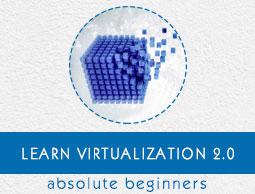Virtualization 2.0 - Pros and Cons
In this chapter, we will discuss some of the most common advantages and disadvantages of Virtualization.
Advantages of Virtualization
Following are some of the most recognized advantages of Virtualization, which are explained in detail.
Using Virtualization for Efficient Hardware Utilization
Virtualization decreases costs by reducing the need for physical hardware systems. Virtual machines use efficient hardware, which lowers the quantities of hardware, associated maintenance costs and reduces the power along with cooling the demand. You can allocate memory, space and CPU in just a second, making you more self-independent from hardware vendors.
Using Virtualization to Increase Availability
Virtualization platforms offer a number of advanced features that are not found on physical servers, which increase uptime and availability. Although the vendor feature names may be different, they usually offer capabilities such as live migration, storage migration, fault tolerance, high availability and distributed resource scheduling. These technologies keep virtual machines chugging along or give them the ability to recover from unplanned outages.
The ability to move a virtual machine from one server to another is perhaps one of the greatest single benefits of virtualization with far reaching uses. As the technology continues to mature to the point where it can do long-distance migrations, such as being able to move a virtual machine from one data center to another no matter the network latency involved.
Disaster Recovery
Disaster recovery is very easy when your servers are virtualized. With up-to-date snapshots of your virtual machines, you can quickly get back up and running. An organization can more easily create an affordable replication site. If a disaster strikes in the data center or server room itself, you can always move those virtual machines elsewhere into a cloud provider. Having that level of flexibility means your disaster recovery plan will be easier to enact and will have a 99% success rate.
Save Energy
Moving physical servers to virtual machines and consolidating them onto far fewer physical servers’ means lowering monthly power and cooling costs in the data center. It reduces carbon footprint and helps to clean up the air we breathe. Consumers want to see companies reducing their output of pollution and taking responsibility.
Deploying Servers too fast
You can quickly clone an image, master template or existing virtual machine to get a server up and running within minutes. You do not have to fill out purchase orders, wait for shipping and receiving and then rack, stack, and cable a physical machine only to spend additional hours waiting for the operating system and applications to complete their installations. With virtual backup tools like Veeam, redeploying images will be so fast that your end users will hardly notice there was an issue.
Save Space in your Server Room or Datacenter
Imagine a simple example: you have two racks with 30 physical servers and 4 switches. By virtualizing your servers, it will help you to reduce half the space used by the physical servers. The result can be two physical servers in a rack with one switch, where each physical server holds 15 virtualized servers.
Testing and setting up Lab Environment
While you are testing or installing something on your servers and it crashes, do not panic, as there is no data loss. Just revert to a previous snapshot and you can move forward as if the mistake did not even happen. You can also isolate these testing environments from end users while still keeping them online. When you have completely done your work, deploy it in live.
Shifting all your Local Infrastructure to Cloud in a day
If you decide to shift your entire virtualized infrastructure into a cloud provider, you can do it in a day. All the hypervisors offer you tools to export your virtual servers.
Possibility to Divide Services
If you have a single server, holding different applications this can increase the possibility of the services to crash with each other and increasing the fail rate of the server. If you virtualize this server, you can put applications in separated environments from each other as we have discussed previously.
Disadvantages of Virtualization
Although you cannot find many disadvantages for virtualization, we will discuss a few prominent ones as follows −
Extra Costs
Maybe you have to invest in the virtualization software and possibly additional hardware might be required to make the virtualization possible. This depends on your existing network. Many businesses have sufficient capacity to accommodate the virtualization without requiring much cash. If you have an infrastructure that is more than five years old, you have to consider an initial renewal budget.
Software Licensing
This is becoming less of a problem as more software vendors adapt to the increased adoption of virtualization. However, it is important to check with your vendors to understand how they view software use in a virtualized environment.
Learn the new Infrastructure
Implementing and managing a virtualized environment will require IT staff with expertise in virtualization. On the user side, a typical virtual environment will operate similarly to the non-virtual environment. There are some applications that do not adapt well to the virtualized environment.


